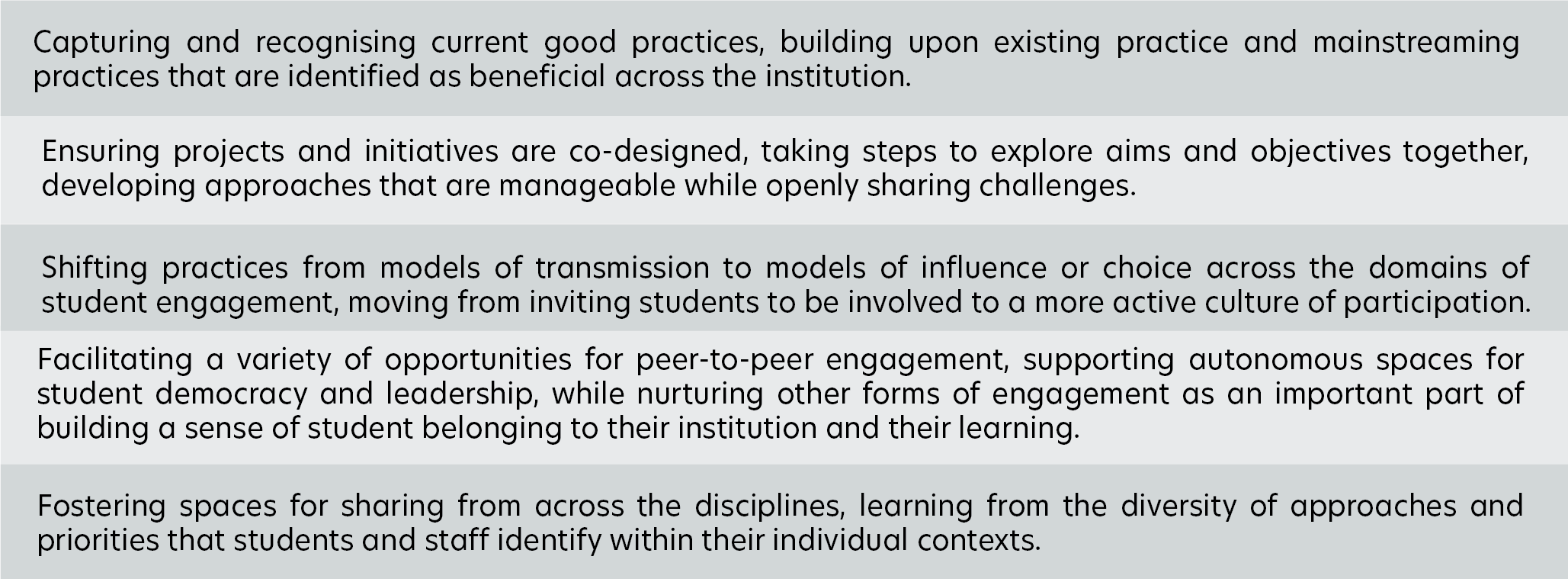
The 5 Enablers of Student Engagement
The five enablers are the ways in which the institution as a whole and those working through the four domains, seek to enact practical, pragmatic, and ambitious approaches.
The enablers of student engagement represent a non-exhaustive approach to supporting enhancement of student engagement and the development of partnership approaches. These enablers are a reflection of the key challenges and ideas that NStEP has gathered from across the Irish higher education sector. Alignment of these enablers to current policies and practices, and as part of new initiatives, can support the emergence of more sustained engagement.
Capacity Building
Effective capacity building can occur through exploration of existing structures and strategies, utilising existing conversations and spaces to weave in the principles of student engagement, and supporting individuals and groups to recognise existing practice upon which to build.

Institutional Approaches
Shared institution-wide approaches can foster a sense of co-ownership and mutual vision or aims. Systematic student engagement values both top-down and bottom-up approaches, recognising that student engagement happens in both unique and commonly understood ways in every corner of the institution.

Supportive Policies and Processes
Embedding good practice in student engagement is an ongoing endeavour which requires space for reflection to learn from it, the development of scaffolding to support it, and opportunities to amplify it.

Communities of Practice
Engagement is elevated to partnership by fostering shared communities of practice between staff and students, underpinned by the concept that students are experts in their own learning experience.

Sustainability
Higher education is a transient sector. Not only do students transition through within a relatively short space of time, but staff changes are also frequent, while policies, activities, and the learning environment rarely stays the same for long. This ever-changing environment can be embraced within student engagement practices, rather than viewed as a barrier.



The 5 Enablers of Student Engagement
The five enablers are the ways in which the institution as a whole and those working through the four domains, seek to enact practical, pragmatic, and ambitious approaches.
The enablers of student engagement represent a non-exhaustive approach to supporting enhancement of student engagement and the development of partnership approaches. These enablers are a reflection of the key challenges and ideas that NStEP has gathered from across the Irish higher education sector. Alignment of these enablers to current policies and practices, and as part of new initiatives, can support the emergence of more sustained engagement.
Capacity Building
Effective capacity building can occur through exploration of existing structures and strategies, utilising existing conversations and spaces to weave in the principles of student engagement, and supporting individuals and groups to recognise existing practice upon which to build.

Institutional Approaches
Shared institution-wide approaches can foster a sense of co-ownership and mutual vision or aims. Systematic student engagement values both top-down and bottom-up approaches, recognising that student engagement happens in both unique and commonly understood ways in every corner of the institution.

Supportive Policies and Processes
Embedding good practice in student engagement is an ongoing endeavour which requires space for reflection to learn from it, the development of scaffolding to support it, and opportunities to amplify it.

Communities of Practice
Engagement is elevated to partnership by fostering shared communities of practice between staff and students, underpinned by the concept that students are experts in their own learning experience.

Sustainability
Higher education is a transient sector. Not only do students transition through within a relatively short space of time, but staff changes are also frequent, while policies, activities, and the learning environment rarely stays the same for long. This ever-changing environment can be embraced within student engagement practices, rather than viewed as a barrier.



The 5 Enablers of Student Engagement
The five enablers are the ways in which the institution as a whole and those working through the four domains, seek to enact practical, pragmatic, and ambitious approaches.
The enablers of student engagement represent a non-exhaustive approach to supporting enhancement of student engagement and the development of partnership approaches. These enablers are a reflection of the key challenges and ideas that NStEP has gathered from across the Irish higher education sector. Alignment of these enablers to current policies and practices, and as part of new initiatives, can support the emergence of more sustained engagement.
Capacity Building
Effective capacity building can occur through exploration of existing structures and strategies, utilising existing conversations and spaces to weave in the principles of student engagement, and supporting individuals and groups to recognise existing practice upon which to build.

Institutional Approaches
Shared institution-wide approaches can foster a sense of co-ownership and mutual vision or aims. Systematic student engagement values both top-down and bottom-up approaches, recognising that student engagement happens in both unique and commonly understood ways in every corner of the institution.

Supportive Policies and Processes
Embedding good practice in student engagement is an ongoing endeavour which requires space for reflection to learn from it, the development of scaffolding to support it, and opportunities to amplify it.

Communities of Practice
Engagement is elevated to partnership by fostering shared communities of practice between staff and students, underpinned by the concept that students are experts in their own learning experience.

Sustainability
Higher education is a transient sector. Not only do students transition through within a relatively short space of time, but staff changes are also frequent, while policies, activities, and the learning environment rarely stays the same for long. This ever-changing environment can be embraced within student engagement practices, rather than viewed as a barrier.



